
CECW-CB
DEPARTMENT OF THE ARMY
U.S. Army Corps of Engineers
Washington, D.C. 20314-1000
ER 5-1-11
Regulation
No. ER 5-1-11
31 Jul 2018
Management
USACE BUSINESS PROCESS
1. Purpose. This regulation establishes policy and doctrine to accomplish all work performed
by the U.S. Army Corps of Engineers (USACE).
2. Applicability. This regulation applies to all USACE activities, all USACE employees, and
all functions.
3. Distribution. Approved for public release, distribution is unlimited.
4. References:
a. Army Regulation (AR) 5-1, Management of Army Business Operations,
https://www.army.mil/e2/c/downloads/441526.pdf
b. Field Manual (FM) 6-22, Leader Development, Jun 2015;
http://www.milsci.ucsb.edu/sites/secure.lsit.ucsb.edu.mili.d7/files/sitefiles/fm6_22.pdf
c. A Guide to the Project Management Body of Knowledge (PMBOK
®
Guide) – 5
th
Ed.,
Project Management Institute, Inc., 2016
d. Engineer Regulation (ER) 5-1-10, Corps-wide areas of work responsibility;
https://www.publications.usace.army.mil/Portals/76/Publications/EngineerRegulations/ER
_5-1-10.pdf?ver=2013-09-08-233246-750
e. Engineer Regulation (ER) 1110-1-8158, Corps-wide centers of expertise program;
https://www.publications.usace.army.mil/Portals/76/Publications/EngineerRegulations/ER
_1110-1-8158.pdf?ver=2013-09-08-233412-167
f. Engineer Regulation (ER) 1110-1-12, Engineering and Design quality management;
https://www.publications.usace.army.mil/Portals/76/Publications/EngineerRegulations/ER
_1110-1-12.pdf?ver=2013-09-08-233407-810
5. Glossary. Provides definitions to ensure a common understanding of key and essential terms.

ER 5-1-11
31 Jul 2018
6. USACE Business Doctrine.
a. Mission-Focused Execution. USACE team members will make resource decisions based
on what is best for the mission, the Nation, and the public, understanding impacts to all
stakeholders. Leaders facilitate smart use of resources, technical competency, and innovation
across the organization with a focus on mission execution. As public servants, all USACE
employees have taken an oath to support and defend the Constitution and, by extension, the
interests of the United States and its citizens. Accordingly, all USACE employees must make
decisions based on the best interests of the Nation, the Army and the public. Recognition of this
preeminent responsibility is critical to properly balancing the many interests that USACE faces
in executing its missions.
b. Teamwork. USACE operates as a team serving the Army and the Nation. USACE seeks
to meet the Nation’s needs as efficiently and effectively as possible. To achieve this, people with
the right skills and tools must work on the right job and at the right time. All organizations must
act in unison across boundaries to draw on combined strengths and leverage the resources of the
public and private sectors to meet national needs. By sharing knowledge, Communities of
Practice (CoPs) in USACE build, maintain and provide expertise and capability to accomplish
the USACE mission.
c. Stakeholder Focus. The execution of all USACE work, project delivery, and program
execution across organizational boundaries must appear seamless to stakeholders. This “one
door to the Corps” concept means that any USACE activity that receives a stakeholder request
for support should ensure that stakeholder receives the best USACE can provide, putting aside
self interests. When a stakeholder develops a trusting relationship with a particular individual or
district, the stakeholder may wish to go through that entity for all their Corps support, even if
outside that entity’s area of responsibility. That entity must ensure they leverage the best and
most cost effective assets from across USACE. Specific programs such as regulatory, Silver
Jackets, and the Flood Plain Management Services for example have designated lead Districts for
each State, which can help to consolidate responsibilities in States with multiple Districts. A
stakeholder is any individual or organization for which USACE delivers projects, or services to
meet specific needs. The primary focus of this regulation are external stakeholders; however the
same guiding principles apply within USACE. For example, Engineering Branch should
consider the PM a stakeholder when they are performing design preparation or design review
activities. Contracting Branch should consider the PM a stakeholder when they are reviewing or
executing the contract acquisition activities.
2

ER 5-1-11
31 Jul 2018
d. Operating Principles. Five universal business process operating principles govern all
work performed by USACE. It is the responsibility of senior leaders to ensure these imperatives
are followed across USACE for all work.
USACE Business Process Imperatives
1. Plan for success and keep commitments.
2. Measure quality with the goals and expectations of the stakeholder in mind.
3. Build effective communications into all activities and processes.
4. Use best practices and seek continual improvement.
5. Use corporate automated information systems consistently and accurately.
Figure 1 – USACE Business Process Imperatives apply to all work
(1) Plan for success and keep commitments. All work must be managed with a written plan.
Planning enables us to fully understand our stakeholders’ requirements and build trust with
stakeholders and coworkers by clarifying expectations, keeping commitments, and ensuring all
products and services are delivered as promised. Each person contributes to success by meeting
the requirements of his or her role, regardless of functional area or echelon within the
organization. People may contribute to mission success individually, as part of a team, or
indirectly as a provider of support services.
(2) Measure quality with the goals and expectations of the stakeholder in mind. Quality is
the degree to which a set of inherent characteristics fulfills requirements. USACE strives to meet
or exceed the goals, objectives, and expectations of the stakeholder, while complying with legal
obligations and administration policy. All employees contribute to our ability to succeed. Each
person is responsible and accountable for the timeliness and quality of his or her work
throughout the duration of the project. Quality is managed through the Plan-Do-Check-Act
cycle, which is described at Appendix B.
(3) Build effective communications into all activities and processes. USACE utilizes
collaborative communication to interact internally as a team and externally with partners, and
stakeholders. Communication is essential to foster cooperation; focused understanding of
requirements and expected outcomes; and the continual improvement to the business processes
that are so vital to continued success. Effective collaborative communication is critical to the
meaningful exchange of ideas, desires, requirements and plans. USACE will make relevant
information fully and readily available consistent with law and national security interests.
(4) Use best practices and seek continual improvement. USACE strives to do the right
things, the right way, for the right reasons, and to constantly improve. Evaluating performance
during and after completion of work, in collaboration with the stakeholder, can produce
opportunities to further improve business processes, in terms of execution, productivity, cost
effectiveness, streamlined processes, timeliness, quality, and stakeholder service. As a learning
organization, USACE uses CoPs to standardize common procedures, and facilitate sharing of
3

ER 5-1-11
31 Jul 2018
knowledge and best practices. CoPs simplify working across boundaries and incorporating
lessons learned. Before beginning any new project, activity or service, each individual must
check for applicable lessons learned and best practices in USACE lessons learned databases.
(5) Use corporate automated information systems consistently and accurately. Consistent,
timely and accurate use of corporate automated information systems (AIS) is required to ensure
data validity, integrity and accessibility. Access to meaningful and accurate Project Management
AIS information is paramount to managing our programs, projects, and meeting stakeholder
commitments. The Project Management Automated Information System (PROMIS or P2) is the
database of record for all Program and Project management data. This corporate data helps
execute enterprise level business processes and provide decision support. All data must be
managed in sufficient detail and in a fashion to achieve interoperability as well as regional and
corporate visibility of essential information that can be seamlessly shared across USACE, its
stakeholders, and partners. All members of the Project Delivery Team are responsible for data
quality in the corporate AISs. For example, different team members may be responsible for the
integrity and validity of data in Corps of Engineers Financial Management System (CEFMS),
Resident Management System (RMS), Lessons Learned, Real Estate Management Information
System (REMIS), Facilities and Equipment Maintenance System (FEMS), Design Review and
Checking System (DrChecksSM), the Enterprise Data Warehouse (EDW), the Project
Management Automated Information System or the Corporate Tool for Virtual Design and
Engineering Data Management, ProjectWise.
e. All work accomplished by USACE is considered part of a program. A program is a
collection of related projects, services, routine administrative and recurring operational
processes, or some mixture of these. Programs are executed to provide projects, products, and
services for both internal and external stakeholders. Programs can be organized by stakeholder
(internal or external), appropriation, similarity of scope, or by other unifying characteristics.
Programs must be managed in line with the overarching principles of the USACE business
process.
7. Project Delivery Process. A project is a temporary endeavor undertaken to create a
unique product, service, or result.
1
The project delivery business process (PDBP) is the
fundamental method used to deliver quality projects at all echelons of USACE (Refer to
Appendix C for a listing of the PDBP processes).
a. Central Tenet of PDBP. The heart of the PDBP is results-focused teamwork. We draw on
the diverse resources of the Corps worldwide to assemble strong multi-disciplinary teams,
unconstrained by geography or organizational boundaries, to best meet the stakeholders’ needs,
and the national/public interests. This regulation empowers Project Delivery Teams (PDTs) with
the authority and responsibility for delivering quality products and services.
1
Project Management Institute, A Guide to the Project Management Body of Knowledge (PMBOK
®
Guide) –
Fifth Edition, Project Management Institute, Inc., 2016. Copyright and all rights reserved. Material from this
publication has been reproduced with the permission of PMI.
4

ER 5-1-11
31 Jul 2018
b. PDBP Imperatives. In addition to the five USACE business process principles, there are
three imperatives that govern the successful completion of projects.
PDBP Imperatives
1. One project, one team, one Project Manager (PM).
2. Manage all projects with a Project Management Plan (PMP).
3. The Project Delivery Team (PDT) is responsible for project success.
Figure 2 – Additional PDBP Imperatives must be applied to Projects
(1) One project, one team, one Project Manager (PM). Each project is assigned to one PDT,
with a single PM for management and leadership across the acquisition life cycle of the project.
Senior Leaders, or their designees, select the PM based on the individual’s abilities to best lead
the specific project, without regard to assigned organizational element. Generally, the PM will
reside in the geographic area of responsibility, but can be elsewhere as needed to meet project
requirements. The PDT consists of everyone necessary for successful development and
execution of all phases of the project, to include a designated technical lead. The stakeholder is
an integral part of the PDT. The PM is responsible for ensuring that the necessary disciplines
and perspectives are represented within the PDT. The technical lead serves as the proponent for
the project’s technical quality. The PDT may be drawn from more than one USACE district or
activity, and may include specialists, consultants/contractors, stakeholders, or representatives
from other federal and state agencies. Team members are chosen for their skills and abilities to
successfully execute a quality project, regardless of their assigned functional or geographic
locations within USACE. Virtual and matrix teams should be used to align USACE efforts and
focus on quality project delivery. The team will expand to include all necessary expertise on a
specific issue, and may include a vertical aspect encompassing the MSC and headquarters.
(2) Manage all projects with a Project Management Plan (PMP). To meet mission
objectives, each project is managed under a project management plan (PMP). A PMP is a
roadmap for quality project delivery. The PM and the PDT work with the stakeholder early in
the project planning process to determine the stakeholder’s needs, and to refine those
requirements in light of quality, safety, fiscal, schedule, legal, communications, change
management and other constraints. The PDT measures its success against the expectations
documented in the PMP, which is an agreement between USACE and the stakeholder that
defines project objectives and project-specific quality control procedures appropriate to the size,
complexity, acquisition strategy, project delivery, and nature of each product. It should be
signed by all PDT members, including the stakeholder, to document their commitment to project
success.
a. The PMP is a living document that should be updated as conditions change. The PM will
inform stakeholders when their requests will cause significant scope, schedule or cost impacts,
and will coordinate any changes to the project with the stakeholder and PDT, updating the PMP
as appropriate. The enterprise PMP Generator, or ePMP, (available on the PMBP portal) is an
enterprise tool that may be used to develop the PMP in order to effectively maintain consistency.
5

ER 5-1-11
31 Jul 2018
b. The PM and PDT will develop and maintain the PMP at a level of detail commensurate
with the scope of the project. PMPs should be concise and succinct, but address all processes
and areas necessary to ensure effective project execution. Minimum requirements for project
management plans are found in the PDBP Manual (Process PROC 2000 and Reference
document REF 8005G). Appendix D covers the minimum requirements of a PMP. Management
of similar projects of limited scope using a program management plan (PgMP) rather than an
individual PMP for each is acceptable. However, when a project under a program is of such
scope that it is no longer manageable under the PgMP, it must be managed with a separate PMP.
For example, a Project Management Plan can be developed for the basic contract for various
O&M activities on an installation; with each subsequent project added as an appendix due to its
unique scope, schedule and budget.
(3) The Project Delivery Team (PDT) is responsible for project success. The PDT is
empowered and supported by senior organizational leaders to make project decisions within the
bounds of the approved PMP. Changes to the project scope, budget or schedule that will affect
the technical quality must be coordinated with the technical lead and brought to the PM’s
attention so the PMP may be revised accordingly. They are empowered to act in unison across
organizational boundaries, focusing on consistent service to stakeholders. Senior leaders are
responsible to ensure the team has the resources, tools, skills and experience needed to deliver a
quality project. Though projects may include many distinct, separate phases, they must be
approached from an integrated, life-cycle perspective, focused on meeting the project’s goals,
objectives, and expectations.
a. The PDT works with stakeholders to determine and provide what is expected, and must
strive to deliver quality products and services that are in the public interest. The needs and
expectations of stakeholders must be balanced, considering available resources and life-cycle
requirements. Expectations of the beneficiaries and/or stakeholders of projects are considered
when determining quality objectives. USACE will not compromise professional standards.
Requirements that exceed mandatory standards are negotiated with the stakeholder based on the
project’s complexity, available resources, and the degree of risk the stakeholder and USACE are
willing to assume.
8. Work Delivery Process.
a. Several key USACE functions are organized around ongoing, recurring, and cyclical work
rather than discrete projects. Other non-project work can include some operations and
maintenance (O&M) activities at completed works, regulatory permitting, flood plain
management, general and administrative support, equipment procurement, and real estate
actions. However, some of this work (e.g. major maintenance, some regulatory work, and real
estate) may include the delivery of unique products, services or results and consequently fit
under the project definition and should be managed in line with the Project Delivery Process.
Some examples of Projects and Work for different mission areas follow:
6
ER 5-1-11
31 Jul 2018
(1) A major Real Estate land acquisition, land disposal, and BRAC-related acquisitions are
considered projects whereas outgrants, renewal of recruiting leases, and management of leases fit
the other work definition.
(2) Fielding a new system is a project in the Corporate Information world, but operating and
maintaining a system to include helpdesk support and sustainment training are other work.
(3) Research and Development (R&D) Projects include basic research (e.g., development of
new and advanced inorganic cements that bond to reinforcing materials), applied research (e.g.,
development of protective measures, decision aids and concepts for base camp protection against
terrorist and conventional contingency environments) and demonstration R&D studies (e.g.,
development of concrete armor unit technology for coastal structures, Core Loc). Additional
project examples include civil (e.g., development of the Regional Internet Bank Information
Tracking System for EPA to assist in day-to-day mitigation banking business) and military (e.g.,
developed and produced for the Army Environmental Center as an alternative to lead bullets for
use on small arms training ranges) reimbursable studies for other federal agencies and state and
local governments. Examples of non-project work include items such as Corps of Engineers
Enterprise Infrastructure Services, (which provides for the 24 hours a day, 365 day per year
primary information technology infrastructure for the Corps,) the day-to-day maintenance and
administrative oversight of the R&D grounds and facilities, and routine/redundant laboratory
testing/analysis.
(4) Most business lines within USACE Operations undertake both project and non-project
work:
(a) Creation of Level 1 inventories and development of an original master plan are projects
for the Environmental Stewardship and Environmental Restoration business lines, while periodic
updating and maintaining those plans are “other work.”
(b) In the Recreation arena, a major park upgrade is a project; operating a visitor center and
operation/administration of a recreation area are non-project work.
(c) Examples of projects in the Navigation and Flood Risk Management Business Lines are
rehabilitation of a lock, restoration of a beach, and large, multi-year or event-driven dredging.
Examples of non-project work in this area include dam safety inspections, lock dewatering, lock
and dam operation and maintenance, and annual or routine recurring dredging occurring under a
single contract.
(d) Planning 3x3x3 feasibility studies, feasibility studies and the creation of a watershed plan
are distinct projects, whereas on-going watershed planning and flood plain management are both
non-project work.
(e) Regulatory projects include individual/standard permit actions and Environmental Impact
Studies (EIS), and wetland delineation. Permit enforcement and handling administrative appeals
are examples of non-project work.
7

ER 5-1-11
31 Jul 2018
(f) Within the Emergency Management/Readiness function, Disaster Recovery and Response
would be considered a program; however, within that program are individual recovery projects
(long-term restoration of the environment for people) such as Debris Removal, Temporary
Housing, and Temporary Roofing. Examples of “other work” are the response (i.e. immediate
30 days or less life-saving) missions of Procuring and Providing Ice and Water, Providing
Emergency Power, and Urban Search and Rescue.
b. Ongoing work must still be planned, executed, and controlled in line with the USACE
business process imperatives described in paragraph 6.d.
2
However, the Project Delivery
processes, as described in paragraph 7, may be used at the discretion of the executing entity. For
example, multi-disciplinary teams are used throughout USACE to execute non-project work such
as normal operations of a recreation area or dam safety inspections.
c. All work will be managed with a control document (ex. Program Management Plan
(PgMP) or other programmatically specified document) for the purpose of allocating funds and
resources, and establishing program goals, objectives, acquisition strategy, and priorities on an
annual basis. A PgMP is a necessity when mission success requires synergy and integration
between individual projects or activities in a program. When an individual project under a
program is of such scope that it is no longer manageable under the PgMP, it must be managed
with a separate PMP.
9. Roles and Responsibilities. HQUSACE, Major Subordinate Commands (MSCs or
Divisions), centers, laboratories, and districts all have direct responsibility for quality and
process improvement. All echelons of USACE work together to ensure and enhance the quality
of our projects and services. The goal is to create an environment that promotes communication,
respect, trust and cooperation. USACE is a public corporate entity operating through Regional
Business Centers (RBCs).
a. HQUSACE has programmatic responsibility of all work within the command;
communicates philosophy and strategic vision through policy allowing subordinates to tailor
services on a case-by-case basis. HQUSACE and MSCs employ vertical teaming such as
Regional Integration Teams and District Support Teams to address work coordination and policy
issues. HQUSACE interacts with national stakeholders, other agencies and private industry
regarding programmatic issues.
b. MSCs manage the RBCs, facilitating results-focused operations, utilizing appropriate
technical resources and innovative practices. MSCs remove encumbrances to regional
excellence. MSCs ensure that stakeholders whose work crosses RBC boundaries receive
seamless service and are responsible for vertical and horizontal coordination and integration.
MSCs perform quality assurance of the RBC quality processes through periodic evaluations
using an integrated approach consistent with the USACE business process.
2
Ibid
8
ER 5-1-11
31 Jul 2018
c. Commanders are ultimately responsible for all that happens or fails to happen in their
organizations. Commanders empower their workforces to operate within the framework of the
USACE business process in executing the mission. The Commander is the leader of the
corporate team, which sets the strategic direction for the organization. Within ERDC and AGC
for example, these responsibilities are vested in the Directors.
d. The Deputy for (Planning), Programs, and Project Management (DPM) has programmatic
responsibility and authority over all work in a District, and is the senior civilian with authority
second only to the District Commander. The DPM is responsible for the vertical and horizontal
integration of all projects and programs, and is charged with delivering them in line with the
USACE business processes. The DPM is responsible for program execution, to include the
approval of project baselines, change control thresholds, communication strategies, and
coordinating changes with the Programs’ vertical team. The DPM provides continuity of
corporate leadership in the assessment and development of programmatic mission and work
requirements and in the establishment of corporate programs, plans, goals, and objectives. The
DPM, as the proxy to the District Commander, is the only other individual who is authorized to
either accept or reject work in the District. The DPM, as leader of the program and project
management staff, is responsible for acceptance of organizational risk, and is the final source of
resolution for disagreements on issues that are legal, ethical and moral.
e. Senior leaders, working as a corporate team, create the conditions necessary for success
through actions and behavior consistent with the USACE business process. The corporate team
promotes the long-term success of the organization through strategic planning. District senior
leaders within the RBC evaluate workload projections, staffing, technical expertise, and market
conditions to ensure that we will be able to support our stakeholders in the future.
f. Mid-Level Leaders work together at the operational level of the organization, with a focus
on executing the current year’s mission and planning for the next year. They provide adequate
resources and delegate authority commensurate with responsibilities to subordinates to facilitate
success and maintain a quality workforce. By working as a team, mid-level leaders can help
ensure selection of optimal execution strategies and maintain technical expertise across the RBC.
g. Resource Providers (Supervisors or Functional Chiefs) at all levels of the organization lead
their staffs to implement the USACE business process to successfully execute the mission. They
maintain a high level of professional expertise within their organizations and are responsible for
the quality of the processes employed to execute all work. They work as a management team to
mentor PDT members in their functional areas, assign work, balance workload and resolve
resource conflicts on an ongoing basis.
h. Program Managers (PgMs) are responsible for management of unique stakeholder
requirements for a set of related projects, services, or activities. They integrate program
information and are responsible for making accurate program projections necessary to support
workload analysis at the local, regional and national level. Program Managers will often be the
POC for interaction with the stakeholder on their assigned program. Program managers include
9
ER 5-1-11
31 Jul 2018
Operations Project Managers responsible for the overall O&M of one or more multi-purpose
water resource development sites, leading teams that execute the projects or recurring work
activities at these sites.
i. The Project Manager (PM) manages scope, schedule, budget and quality while leading a
PDT across the project’s acquisition life cycle to successful execution. This individual is the
primary interface with the stakeholder and is also the Corps of Engineers’ primary internal
advocate for the specific project. PMs manage all project resources, information and
commitments, integrate and focus the efforts of the PDT and proactively manage all project
risks. The PM’s active role as consultant is essential to ensure that the stakeholder’s quality
objectives are clearly articulated and that the stakeholder understands the essential professional
standards, laws, and codes, as well as public trust issues that must be incorporated into the
project. In performing these functions, the PMs must operate consistent with their
responsibilities as a public servant (federal official). PMs provide PDT leadership and
collaborative management with responsibility for assuring that the project stays focused on the
public interest and on the stakeholder’s needs and expectations. PMs must rely on the most
appropriate method of communications (i.e. verbal, written or face to face meetings) to
accomplish the work.
j. The Technical Lead (TL) serves as the proponent for technical quality of deliverables
throughout the life of the project. This team member coordinates with the PM to provide
project-specific information for inclusion in the Quality Management Plan (QMP) as part of the
PMP. The QMP must include stakeholder quality objectives, as well quality control and quality
assurance plans developed in line with district-established procedures. Revisions to the project
scope, budget, or schedule that affect project quality may not be made unilaterally and must be
coordinated with the technical lead to ensure quality objectives are still achieved at project
completion.
k. The PDT is responsible and accountable for delivering a quality project to the stakeholder,
actively resolving problems and issues as they carry out effective, coordinated actions to deliver
the completed project according to the PMP. Team members are responsible and accountable to
the PDT for the timeliness and quality of their own work, and for keeping commitments for
completion of their portion of the project as documented in the PMP, as well as coordination
with and keeping all other team members informed. Each PDT member represents their
functional organization and must be empowered to make commitments and decisions on that
organization’s behalf; likewise, each PDT member is expected to communicate back to their
functional element all relevant decisions, commitments and expectations.
l. FOA staff elements such as Counsel and Contracting are key members of the PDT. Office
of Counsel assists the PDT in providing legal opinions and legal sufficiency reviews.
Contracting PDT members actively participate in the project planning process and represent the
procurement functional area in advising the PDT across the acquisition planning process.
10
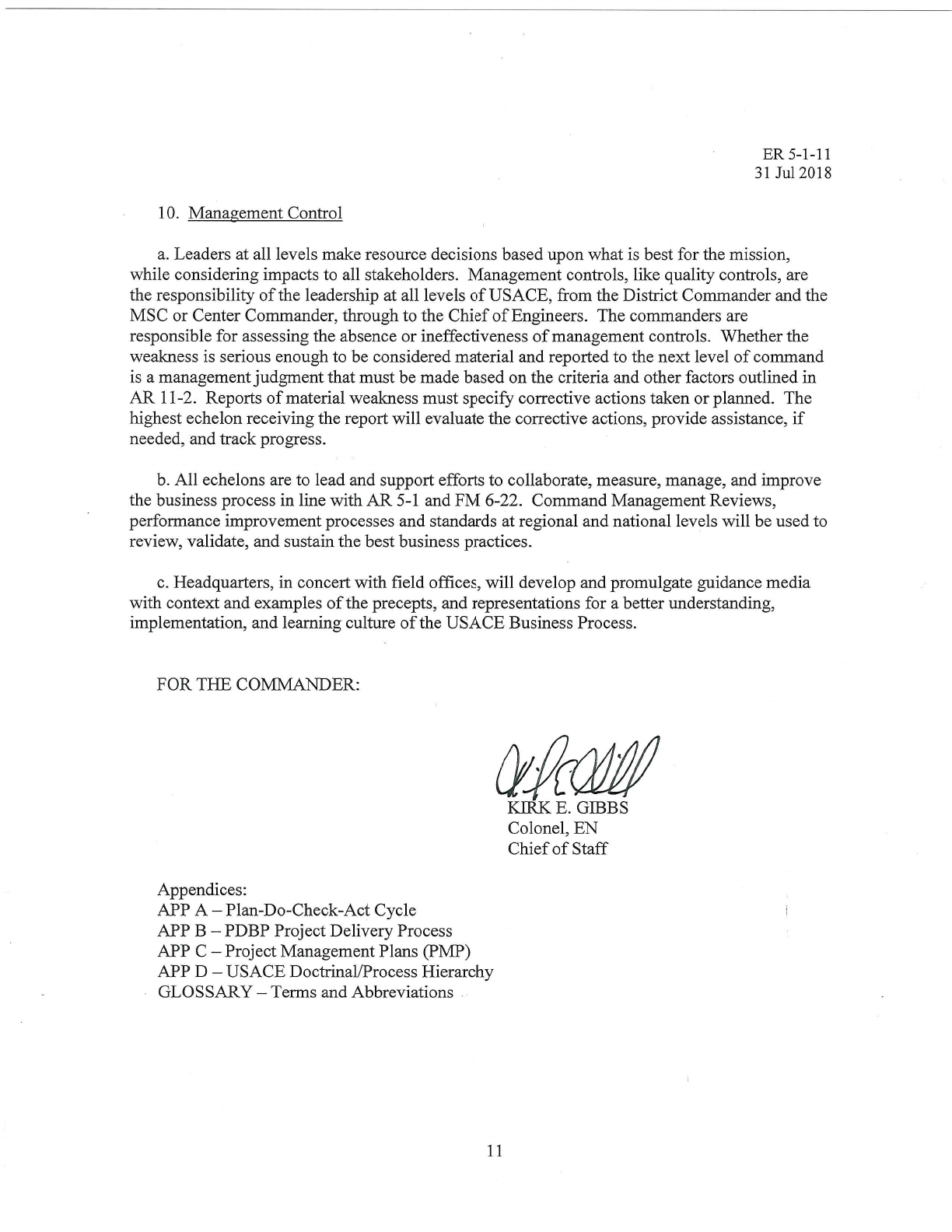
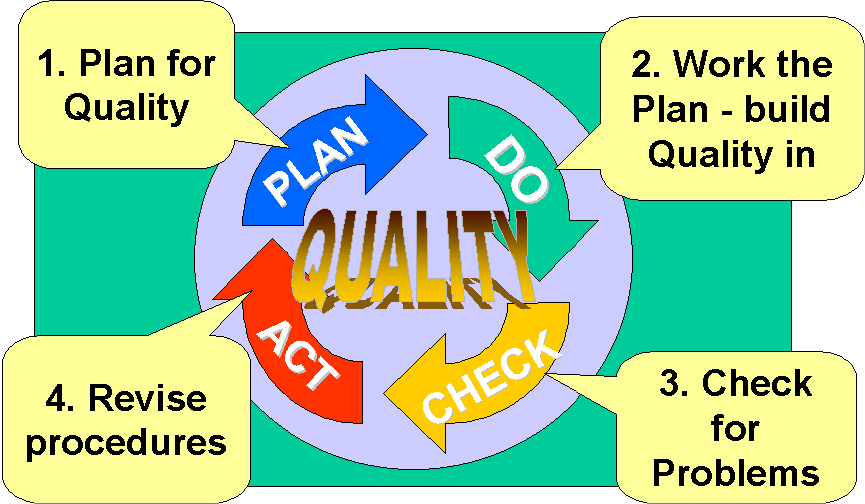
ER 5-1-11
31 Jul 2018
APPENDIX A
Plan-Do-Check-Act Cycle
Figure 3- Plan-Do-Check-Act
1. Plan: We assign the right people with the right skills and tools to work on the right project.
We plan for and build quality into our work at each step in the process. We use a systematic
planning process to identify the stakeholder’s quality goals; develop an effective plan and
processes to achieve those goals, and measure our attainment of the quality objectives. We help
our stakeholders to express their desired outcomes in objective, quantitative terms. We
communicate with our stakeholders to ensure mutual understanding of standards and processes.
It is essential that the project team, which includes the stakeholder, understand the costs and
benefits of selected quality standards and the processes to be used to achieve mutual objectives.
We identify appropriate standards and determine how to achieve them, consulting lessons
learned on previous projects as appropriate. We consider the risk factors and complexity of each
project, and adapt processes to provide the requisite level of quality. We consult, advise, and
reach consensus with the stakeholder before we do work. We use value engineering when it
serves to increase the quality of our projects. The product of the planning phase is the project
management plan (PMP).
2. Do: We then do the work according to approved PMPs and documented procedures. Our
procedures are developed and documented with sufficient detail to ensure that actions are
performed correctly and completely each time. Project and program execution is a dynamic
process. The team must communicate and adapt to changing conditions and modify project
plans to ensure project objectives are met. Quality management consists of executing a well-
conceived and continually updated PMP.
A-1
ER 5-1-11
31 Jul 2018
3. Check: We perform sufficient independent technical review, management oversight, and
verification to ensure that we meet the quality objectives documented in the PMP. Team
members periodically check performance against the plan and verify sufficiency of the plan and
actual performance to meet or exceed agreed-on objectives. After action reviews are conducted
to facilitate sharing of lessons learned. Findings are shared with the project teams and other
personnel to facilitate continuous improvement.
4. Act: We take specific corrective actions to remove the systemic cause of any non-
conformance, deficiency, or other unwanted effect. We improve quality through systematic
analysis and refinement of work processes. The process of continuous quality improvement
leads to the refinement of the overall quality system. Quality improvements include appropriate
revisions to quality management plans, alteration of procedures, and adjustments to resource
allocations.
A-2
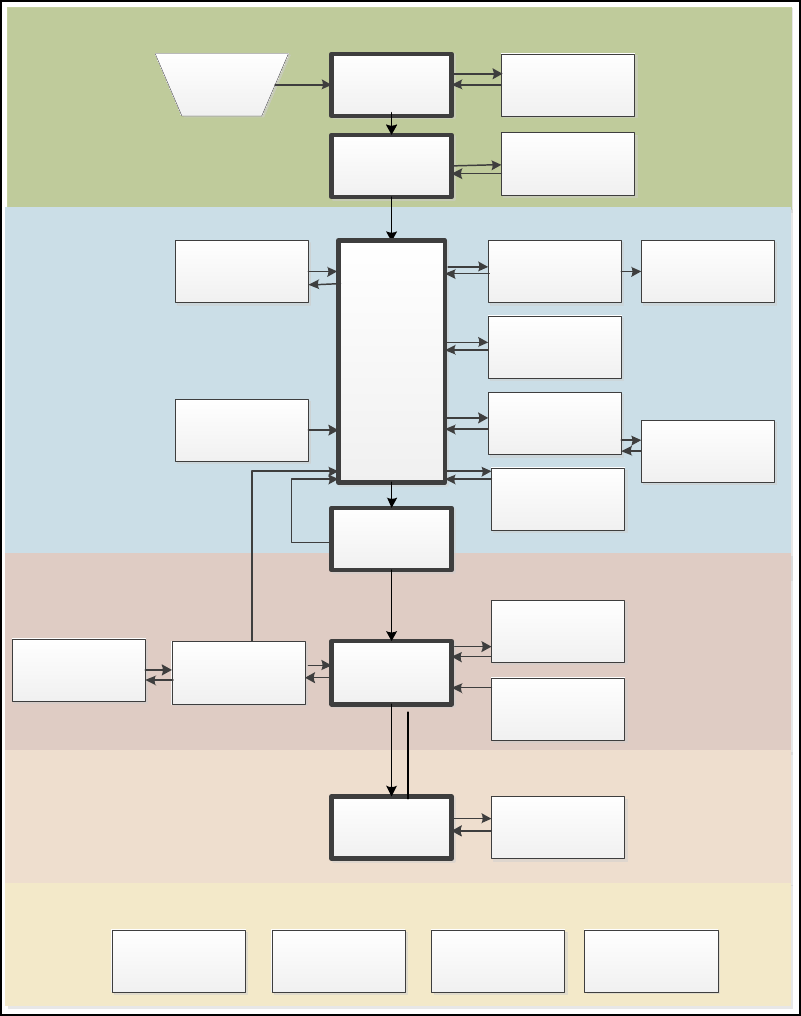
ER 5-1-11
31 Jul 2018
APPENDIX B
PDBP Project Delivery Process
Project Initiation Phase
Project Planning Phase
Project Execution and Control Phase
Project Closeout Phase
District/Center Regional References
ID Customer
Need or
Request
Work Acceptance
[PROC1000]
Workload Analysis &
Resource Leveling
[PROC1020]
Initiating Project in
P2
[PROC1030]
Receipt of Funds
[PROC1040]
After Action Review
(AAR)/ Lessons
Learned
[PROC3020]
Change
Management
[PROC3010]
Project Execution
& Control
[PROC3000]
Overall Acquisition
Strategy
[PROC2060]
Activity/Project
Closeout
[PROC4000]
After Action Review
(AAR)/ Lessons
Learned
[PROC3020]
Manpower
Requirements
[REF6000]
Operating Budget
[REF6001]
Regional Overall
Acquisition Strategy
[REF6002]
Regional Business
Center Workload
Analysis &
Resource Leveling
[REF6003]
PMP
Development
[PROC2000]
Project Scope and
Customer
Requirements
Definition
[PROC2010]
Team Establishment
[PROC2020]
Workload Analysis &
Resource Leveling
[PROC1020]
Activity/Schedule
Development
[PROC2030]
Resource Estimate
Development
[PROC2040]
Workload Analysis &
Resource Leveling
[PROC1020]
Project Delivery
Acquisition Strategy
[PROC2050]
Overall Acquisition
Strategy
[PROC2060]
PMP Approval
[PROC2070]
Receipt of Funds
[PROC1040]
Figure 4 – Project Delivery Business Process (PDBP) flowchart
B-1
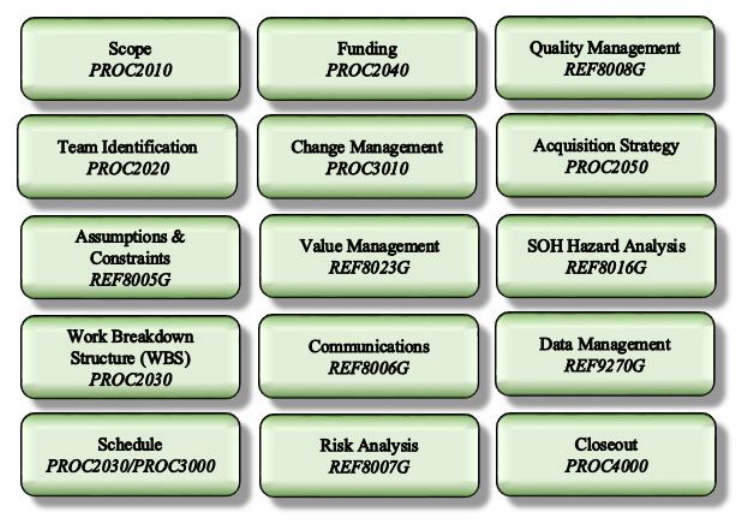
ER 5-1-11
31 Jul 2018
APPENDIX C
Minimum PMP Content
A PMP is a roadmap for quality project or work delivery and should focus on the key
deliverables that will drive the PDT to successfully meet its commitments. The PMP will
include the following at a minimum: Scope, PDT roles, Assumptions and Constraints, WBS,
Schedule, Funding, Change management, Value Management, Risk, Communications, Quality,
Acquisition Strategy, Safety, Data Management and close-out. The PMP approval should be
delegated to the lowest appropriate supervisory level in order to maintain a minimal level of
management control. Processes such as Safety, Quality, Risk, Change Management and
Communications may be addressed in a programmatic plan or at the organizational level
(Branch, Division or District) for a program or a portfolio of similar projects. The enterprise
PMP Generator, or ePMP, (available on the PMBP portal) may be used to develop the PMP in
order to effectively maintain consistency and comply with the Federal Records Management Act.
Figure 5 – Minimum content of the Project Management Plan
1. Scope – The scope forms the boundary of the project. It is not a list of everything to be done;
it is the end result(s) the project should produce. The scope should define the stakeholders’
requirements and the acceptance criteria.
C-1
ER 5-1-11
31 Jul 2018
2. Team Identification – For each assignment or task the PM must identify the team members
who will accomplish the work/deliverables. A critical step in effectively managing and
delivering projects is to formally assign roles and responsibilities to PDT members.
3. Critical Assumptions and Constraints - Assumptions and constraints are considered to be true
at the time the PMP is written and approved. The assumptions could cause major impact to
the project; constraints are items that limit the PDT’s options.
4. Work Breakdown Structure (WBS) – The WBS is a deliverable-oriented hierarchical
decomposition of the work to be executed by the PDT to accomplish the project objectives
and create the required deliverables. It organizes and defines the total scope of the project.
Each descending level represents an increasingly detailed definition of the project work.
5. Schedule – The PM should prepare a schedule, with the assistance of the PDT, for even the
smallest projects. The PDT should use their judgment to develop realistic activity durations.
The schedule enables the PM/PDT to determine which activities are required to produce a
deliverable, estimate how long the activities will take, calculate the resources required to
deliver the project and assign activities and responsibilities.
6. Project Cost – After ensuring that each team member is clear on what they have to produce,
develop estimates of the number of hours required to produce the deliverables. PDT
members must be engaged in this process in order to secure their commitment.
7. Change Management – Change Management (CM) refers to any approach to transitioning
individuals, teams, and organizations using methods intended to re-direct the use of
resources, business process, budget allocations, or other modes of operation that significantly
reshape a project or program. CM should be a deliberate process with approval by the PM,
PDT, District/Division leadership and the stakeholder.
8. Value Engineering – Value Management (VM) is a process to facilitate and encourage the
understanding, consideration, and integration of the needs of all customers, PDT members,
partners, and stakeholders. Value Management seeks the highest value for a project by
balancing resources and quality.
9. Communications and Reporting – The Communications Plan describes how the PDT will
communicate with the stakeholder(s), each other and include a discussion of the
stakeholder’s requirements for status reporting.
10. Risk Management – Risk Management is a systematic process of identifying, analyzing, and
responding to risk for the entire project life‑cycle. This process should be performed at the
initial stage and then monitored and controlled throughout the life of the project. The level
of detail of the Risk Management Plan should be commensurate with the project’s
complexity.
C-2
ER 5-1-11
31 Jul 2018
11. Quality Management – The Quality Management Plan includes the degree to which a set of
inherent characteristics fulfills requirements. Standard quality management procedures are
usually defined at the program or organizational level, however, project specific quality
objectives must be identified and the procedures for ensuring quality control and quality
assurance referenced.
12. Acquisition Strategy – Acquisition planning is the strategy by which the procurement
decisions are coordinated and integrated to ensure the delivery of the project’s deliverables.
13. Safety – The Safety and Occupational Health Plan addresses how safety and health measures
will be integrated into the project’s phases. The plan includes safety and health
responsibilities, standards, requirements and criteria, and hazard analysis requirements and
any safety and health testing/assessment requirements.
14. Data Management – Data Management (DM) is a process and standard for the collection and
life cycle maintenance of data used by the PDT members, partners, and stakeholders. Data
Management is also a key component to Value and Quality Management.
15. Closeout – Project close-out is an essential step for every project to ensure that the team
documents Lessons Learned and transfers the property to the stakeholder.
C-3
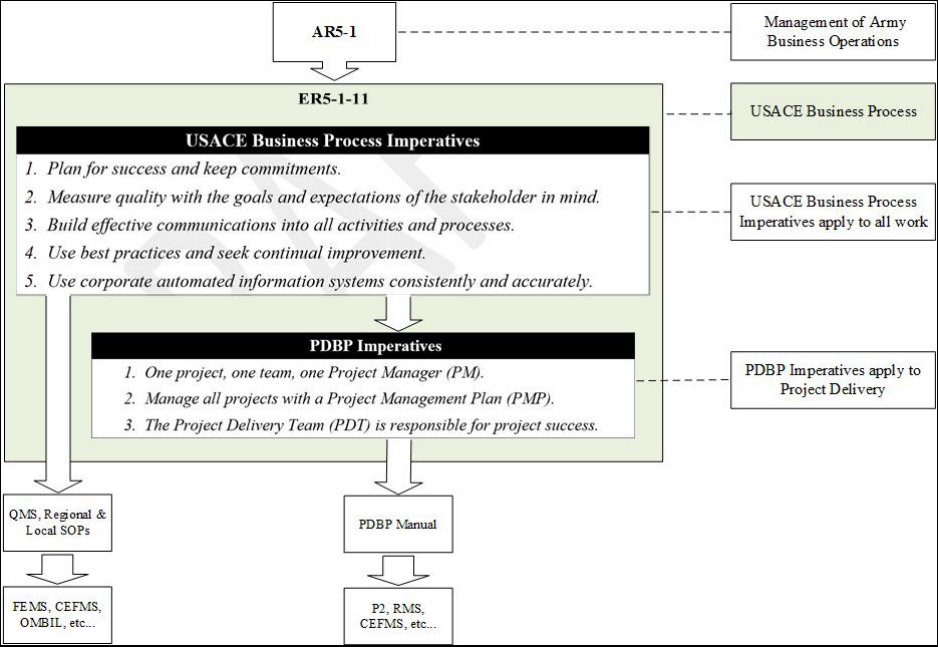
ER 5-1-11
31 Jul 2018
APPENDIX D
USACE Doctrinal/Process Hierarchy
Figure 6 – Process Hierarchy
The above is a graphical representation of the organization of ER 5-1-11 as well as its
relationship to other doctrine, business processes and AIS’s.
The USACE Business Process Imperatives are applicable across the organization, just as we
apply the Army values within USACE. These universally applicable principles include, for
example: planning for success, measuring goals based on stakeholder expectations, emphasizing
effective communications, seeking best practices and maintaining accurate corporate data.
The Project Management Delivery Process, PDBP, focuses on the management of projects,
while other processes focus on the management of other work. Although both types of work
share important characteristics applying the most appropriate processes and tools to different
types of work will bring greater efficiencies and effectiveness to each.
D-1
ER 5-1-11
31 Jul 2018
All USACE work (“project” or “other”) requires effective management by the best, and most
appropriate, business rules and tools applicable to the requirement. Some of these requirements,
and tools, will vary between such efforts as the Civil Works Regulatory Program and the FUDS
program, or between lock operations and CFO compliance. It is, however, key for the success of
the Regional Business Centers (RBC) and for USACE efforts across division boundaries that
individual functional processes should remain consistent across all USACE commands.
Furthermore, an important element for all business management processes and tools is the
capability to capture resources required to perform all work. All USACE efforts will be captured
in P2; however, the level of detail will be dependent upon the specific program and category of
work.
D-2

ER 5-1-11
31 Jul 2018
GLOSSARY
Terms & Abbreviations
Automated Information Systems (AIS): A combination of computer hardware and software,
telecommunications information technology, personnel, and other resources that collect, record,
process, store, communicate, retrieve, and display information.
Community of Practice (CoP): A group of people who regularly interact to collectively
learn, solve problems, build skills and competencies, and develop best practices around a shared
concern, goal, mission, set of problems, or work practice. More information on the various
communities of practice in USACE is available from their respective websites.
Corporate Board (CB): A group of District or Center leaders who make resource decisions
based upon what is best for the mission, while considering impacts to all stakeholders.
Deputy for Programs and Project Management (DPM): The civilian deputy to the District
Commander. DPM as used in this regulation includes Center positions such as Deputy for
Programs and Technical Management and Deputy for Programs and Project Management/Project
Delivery Team. The DPM is authorized to accept and/or reject work by PDBP Process 1000,
titled work acceptance.
District Support Teams (DST): Cross-functional teams at MSC that facilitate resolution of
issues and champion district causes.
Empowerment: Authority to exercise judgment and take action, with concomitant
responsibility for resultant positive or negative consequences.
Field Operating Activities (FOAs): Districts, Centers or Laboratories are referred to as FOAs
in this ER. Major Subordinate Commands (MSCs) are Division offices.
Functional Organization: Organization structure in which staff are grouped by technical
specialty.
Mega Projects: Projects with specific attributes (cost, time, risk, national significance,
uniqueness and overlapping dependencies) named by HQUSACE Civil Works and Military
Programs Directors in a yearly ECB. Mega projects require enhanced management controls.
Matrix Team: Group of people working across organization boundaries for a common
purpose.
Glossary-1

ER 5-1-11
31 Jul 2018
Operations:
a.) The ongoing execution of activities that produces the same product or provides a
continuous or repetitive service. The objective of ongoing operations is to sustain something
(business, facility).
b.) Within USACE, the organization that operates and maintains facilities and services that
provide river and harbor navigation, flood damage reduction, water supply, hydroelectric power,
recreation, environmental and fish and wildlife sustainment, restoration and protection. Its
Regulatory mission protects the Nation's waterways and wetlands; and it undertakes disaster
relief and recovery work through its Emergency Management/Readiness function.
Operations Project Managers (OPM): Managers responsible for the overall O&M of one or
more multi-purpose water resource development sites, leading teams that execute the projects or
recurring work activities at these sites.
Process: A series of actions, tasks, or procedures with a common objective to achieve an end
or result.
Program: A collection of related projects, services, routine administrative and recurring
operational processes, or some mixture of these, which are managed in a coordinated way to
obtain benefits and control not available from managing them individually.
1
Programs may be
categorized by funding source (type), stakeholder, similarity of scope, or other common criteria
for which resources are allocated and collectively managed.
Program Management: The centralized, coordinated management of programs within
available resources, in line with applicable laws, policies, and regulations, to achieve strategic
benefits and objectives.
2
Under program management, programs, projects and non-project
activities are aggregated for oversight and direction by the organization’s senior leadership.
Program Manager (PgM): Assigned to manage unique stakeholder requirements for a set of
related projects, services, or activities. Program managers include Operations Project Managers
responsible for the overall O&M of one or more multi-purpose water resource development sites,
leading teams that execute the projects or recurring work activities at these sites.
Program Management Plan (PgMP): A formal, approved, living document used to define
program requirements and expectations, including accountability and performance
measurements, and guide program execution and control. The PgMP is the 'umbrella' process for
completion of project planning phase. This process is performed after the work has been
accepted and the Project Manager assigned.
1
Ibid
2
Ibid
Glossary-2

ER 5-1-11
31 Jul 2018
Project: A temporary endeavor undertaken to create a unique product, service, or result.
3
Internal services are discrete projects when they are unique and non-recurring.
Project Delivery Team (PDT): The PDT is a cross-functional matrixed team that includes all
the necessary functional and support personnel with the requisite skills and expertise, from the
District, Divisions, Centers of Expertise and/or labs, in order to deliver the project.
Project Management: The application of knowledge, skills, tools, and techniques to project
activities in order to meet project requirements.
4
Project Manager (PM): Assigned to achieve the project objectives, the person who manages
scope, schedule, budget and quality while leading a project delivery team (PDT.) Project
managers may be assigned to any organizational or geographic element.
Project Delivery Business Process (PDBP): A fundamental subset of the USACE business
process used to deliver quality projects. It reflects the USACE corporate commitment to provide
“stakeholder service” that is inclusive, seamless, flexible, effective, and efficient. It embodies
communication, leadership, systematic and coordinated management, teamwork, partnering,
effective balancing of competing demands, and primary accountability for the life cycle of a
project.
Project Management Plan (PMP): A formal, approved, living document used to define
requirements and expected outcomes and guide project execution and control. The PMP is the
'umbrella' process for completion of project planning phase; it is performed after the work has
been accepted and the Project Manager assigned. The primary uses of the PMP are to facilitate
communication among participants, assign responsibilities, define assumptions, and document
decisions to establish baseline plans for scope, cost, schedule and quality objectives against
which performance can be measured, and to adjust these plans as actuals dictate. The PMP is
developed by the project delivery team, including the stakeholder. The approval of the PMP
should be delegated to the lowest appropriate supervisory level in order to maintain a minimal
level of management control.
Quality: The degree to which a set of inherent characteristics fulfills requirements.
Quality Assurance (QA): That part of quality management focused on providing confidence
that quality requirements of a project, product, service, or process will be fulfilled. QA includes
those processes employed to ensure that QC activities are being accomplished in line with
planned activities and that those QC activities are effective in producing a product that meets the
desired end quality.
3
Ibid
4
Ibid
Glossary-3

ER 5-1-11
31 Jul 2018
Quality Control (QC): That part of quality management focused on fulfilling quality
requirements of a project, product, service, or process. It includes those processes used to ensure
performance meets agreed upon stakeholder requirements that are consistent with law,
regulations, policies, sound technical criteria, schedules, and budget.
Resource Provider: A functional chief responsible for mentoring, training of PDT members,
assigning work, balancing workload and resolving resource and priority conflicts on an ongoing
basis.
Regional Business Center (RBC): An MSC and its districts acting together as a regional
business entity. This vertical and lateral integration of organizational capabilities, resource
sharing, technical expertise, project management, and project delivery broadens and enhances the
range of services and quality within the region.
Regional Integration Team (RIT): Cross-functional teams at HQUSACE that facilitate
resolution of issues and champion RBC causes.
Stakeholder: Stakeholder as used in this regulation may be a number of
people/organizations. In general, the stakeholder is any individual or organization for which
USACE delivers projects, or services to meet specific needs. Stakeholders may be either
external or internal to USACE. For example, Engineering Branch should consider the PM a
stakeholder when they are performing design preparation or design review activities.
Contracting Branch should consider the PM a stakeholder when they are reviewing or executing
the contract acquisition activities.
Technical Lead (TL): Designated PDT member responsible for ensuring technical quality is
achieved. Role may be filled by a design manager, discipline lead, or senior technical team
member and assigned by the district division that is responsible for technical deliverables. Must
be involved in all project decisions that affect quality management processes. For projects that
require professional engineering services, the technical lead must possess an active professional
registration (e.g. P.E., R.A., P.L.A., P.G.), unless waived by the division chief responsible for
Engineering.
Vertical Team: Team that is composed of personnel from different command levels in the
organization, i.e. MSCs and/or HQ.
Virtual Team: Team working across geographic or organizational boundaries without
physical co-location.
Work: Sustained physical or mental effort or activity directed toward the production or
accomplishment of something. Work of a business can generally be categorized as either
projects or operations, although there may be some overlap.
Glossary-4
